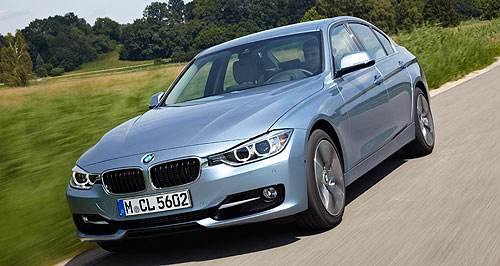News - General News - EmissionsNew-car emissions continue to fallActive measure: Introducing models such as the 3 Series ‘ActiveHybrid’ has taken BMW to the top of the Australian industry in terms of average CO2 emissions. Average CO2 for light vehicles in Australia down to 192g/km, but more could be done25 May 2014 By TERRY MARTIN THE average carbon dioxide emissions rating of new passenger cars and light commercial vehicles on sale in Australia fell 3.4 per cent in 2013 to 192 grams per kilometre, according to figures released by the National Transport Commission last weekend. The new mark represents a continuing decline in CO2 tailpipe emissions for light vehicles and the third-highest drop since annual figures were first published in 2002, with the reduction driven by consumer preferences for smaller and more fuel-efficient vehicles rather than mandatory targets and green-car incentives which remain off the agenda in Canberra. Australia’s CO2 average for passenger cars last year was 182g/km – a 4.2 per cent improvement on 2012 – while light commercials came in at 236g/km, down just 0.8 per cent on the previous year. In Europe, where emissions calculations are directly comparable with Australia and tough regulations are in place, the CO2 average for passenger cars fell four per cent last year to just 127g/km while light commercials were down by a similar margin to 173g/km. Figures released by the European Environment Agency last month show the Netherlands had the EU’s lowest CO2 average for new cars in 2013 (109g/km). Latvia and Estonia offered the least-efficient cars – 147g/km each – albeit with an average that was considerably lower than Australia’s. The UK recorded 128g/km for passenger cars, down 3.6 per cent on 2012, while LCVs fell 1.2 per cent to 186g/km. Europe has mandated a target of 95g/km for all new cars by 2021 (phased in from 2020) – equivalent to approximately 4.1 litres per 100km of petrol or 3.6L/100km of diesel – while the US has a target of 139g/km by the end of the decade. In Australia, the former Labor federal government had mooted mandatory CO2 targets under Julia Gillard in 2010 – including a figure of 155g/km by 2024 – but subsequently refused to commit to them. There are no such moves on the horizon from the Abbott government, despite allocating around $1.15 billion over the next four years to its ‘emissions reduction fund’ designed to help the Coalition cut CO2 to five per cent below 2000 levels by 2020. According to the NTC, cars and light commercials are responsible for 10 per cent of Australia’s carbon emissions. NTC chief executive Paul Retter described the fifth successive fall in annual vehicle CO2 emissions as encouraging, but said more could be done. “If every Australian who bought a car last year chose the most efficient vehicle on offer, the average vehicle emissions wouldn’t have fallen just 3.4 per cent – it would have fallen ten times that amount,” said Mr Retter, pointing to a potential national average of 126g/km. “Consumer preferences, manufacturers producing greener vehicles and government regulation are all factors that can reduce carbon emissions from our vehicles.” Defining a ‘green car’ as one producing less than 120g/km, the NTC says that 2.2 per cent of the cars purchased in Australia last year were green, compared to 1.2 per cent in 2012 and just 0.8 per cent in 2011. That said, VFACTS registration figures show that of the 900,000 passenger vehicles (including SUVs) sold in Australia last year, less than 300 of these were electric cars or plug-in hybrids. In Europe, by comparison, where 11.8 million new cars were registered last year, 24,000 of these were EVs and around 31,000 were plug-in hybrids. The average CO2 emissions from Australian-made vehicles last year was 210g/km, which represents no improvement over 2012 and comes despite around $340 million in specifically targeted green-car federal funding, among other government grants and industry investments, in recent years. Toyota’s Altona-built Camry mid-size sedan (including hybrid) and Aurion large car were the best of the locally made vehicles with combined emissions of 179g/km, compared to Holden’s Adelaide-built range of small and large cars (213g/km) and Ford’s Broadmeadows-built large models (237g/km). As was the case last year, private buyers, rather than business or government buyers, had the lowest average emissions in their purchasing – 186g/km compared to business (198g/km) and government (210g/km). Among vehicle brands, Suzuki and BMW had the equal lowest average emissions figure last year (158g/km), while Jeep had the highest (226g/km). While Europe’s stringent regulations are the driving force behind its lower emissions, the NTC says Australian consumers continue to have a stronger preference for heavier vehicles with larger and more powerful engines – most often with a petrol rather than diesel engine – and an automatic transmission. Australian buyers also have less choice of truly green vehicles than in Europe – a consequence, according to many car companies, of the lack of regulation and incentives here – as well as lower fuel costs, the latter providing little motivation to buy a more fuel-efficient and lower-emitting car.  Read more14th of March 2013  New cars clean up their actAustralia’s average exhaust pipe emissions falls, but we still lag Europe14th of March 2012  New vehicle emissions fall – but not enough, says NTCTransport Commission says Oz buyers need to make greener purchasing decisions6th of February 2012  Vehicle CO2 emissions drop 2.8 per centLatest good news on carbon emissions might pave the way for stiffer car standards |
Click to shareGeneral News articlesResearch General News Motor industry news |















Facebook Twitter Instagram